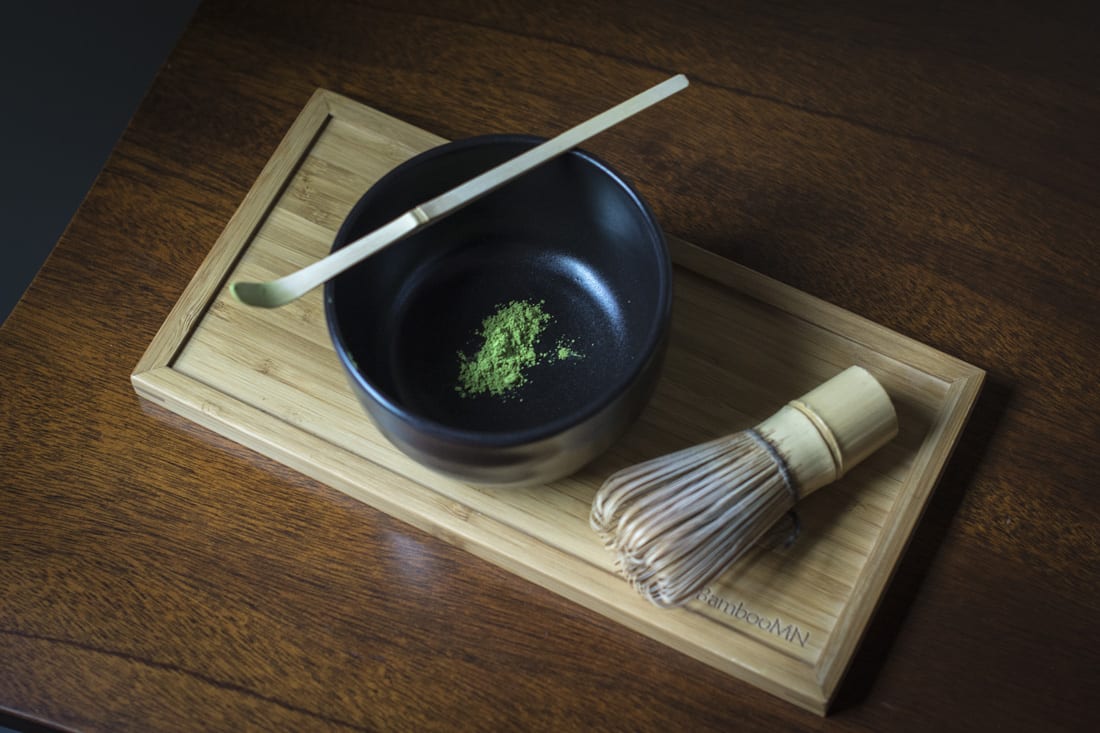SAVORING THE RITUAL OF MATCHA TEA
STORY: Angela Hansberger
Tranquil voices, the gentle sound of a bamboo whisk, steaming bowls of foamed molten vibrant green—there’s so much more to a cup of matcha than pouring hot water over crushed tea leaves. Matcha is Zen in a cup. Matcha is on drink menus and in pastry cases these days in everything from ice cream to doughnuts. You can even pull up to the drive-through at Starbucks and order a Matcha Green Tea Latte. It may seem like a trend, but it’s been a thing in China and Japan for centuries.
Japanese Samurai warriors as far back as the 13th century enjoyed a tea ceremony before a match for energy and focus. There is a meditative act in preparing, presenting and sipping a cup of matcha. Chinese Zen Buddhists drank it as a connecting ritual for clarity with focusing on the now.

So what sets matcha apart from regular green tea? Matcha comes from the same tea bushes (camellia sinensis) as all true tea. What distinguishes it is how it’s processed. Several days before harvest, farmers build structures around the plants to shade them. The highest-grade matcha grows in near darkness by harvest time. The decreased light encourages plants to crank out a boost of chlorophyll and amino acids. This is where the vibrant green color, and possibly the health benefits, originates. The newest growths, just developing at the very top, are softer, sweeter and delicate. These pristine leaves are the only ones picked for matcha.
After harvest, the leaves get quickly steamed. They are laid out to dry and then placed in rotating drums to finely grind them without damaging their chemical composition. What’s left is a delicate, bright-green powder.
A wealth of information is available on the health benefits of matcha. It contains three times as many antioxidants as standard green tea. Antioxidants are the substances in food that safeguard the body by protecting cells from damage, thus lowering blood pressure and favorably changing cholesterol numbers. It has a natural calming effect, too. The powder is rich in L-theanine, which promotes a state of relaxation in the body. Matcha increases metabolism, revving up calorie burning.
 Zentea in Chamblee has everything you need for a matcha tea service. Tea barista Anna Finco walked us through the various steps. First, make sure your matcha is fresh. If it’s not bright green, it’s probably past its prime and will taste bitter. Heat water to almost boiling in a tetsubin, a traditional cast iron teapot. Use 2 to 4 ounces of water with 1 to 2 teaspoons of matcha powder. First, scoop the powder into your cup or chawan (wide-brimmed bowl). Break up the powder until smooth with a chasen (bamboo whisk). Add a small amount of water to form a paste. Add the rest of the water and whisk in a zigzag pattern. “You want to create a foam,” says Finco. “If I was making a latte, I would pour this into hot milk.” Then sit back, relax and sip the earthy, vegetal deliciousness and you will be on your way to sado or chado—“the way of tea.”
Zentea in Chamblee has everything you need for a matcha tea service. Tea barista Anna Finco walked us through the various steps. First, make sure your matcha is fresh. If it’s not bright green, it’s probably past its prime and will taste bitter. Heat water to almost boiling in a tetsubin, a traditional cast iron teapot. Use 2 to 4 ounces of water with 1 to 2 teaspoons of matcha powder. First, scoop the powder into your cup or chawan (wide-brimmed bowl). Break up the powder until smooth with a chasen (bamboo whisk). Add a small amount of water to form a paste. Add the rest of the water and whisk in a zigzag pattern. “You want to create a foam,” says Finco. “If I was making a latte, I would pour this into hot milk.” Then sit back, relax and sip the earthy, vegetal deliciousness and you will be on your way to sado or chado—“the way of tea.”
ZENTEA
5356 Peachtree Rd.
Chamblee 30341
678.547.0877
zenteaco.com


















